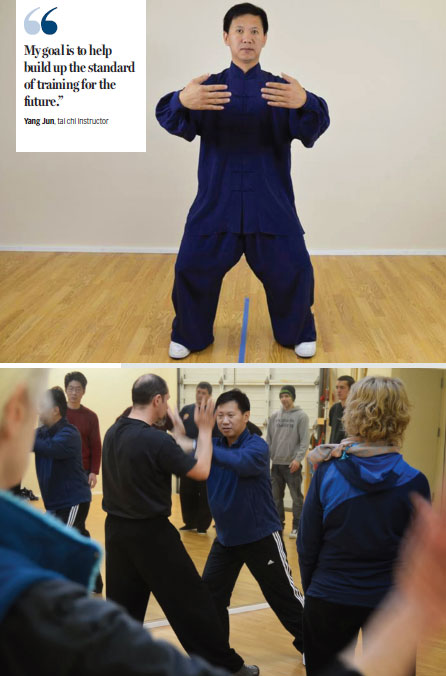Rooted in China, tai chi branches out
Updated: 2016-08-26 12:05
By Linda Deng in Seattle(China Daily USA)
|
||||||||

A direct descendant of one of the martial arts' legendary founders, Yang Jun carries on a tradition
Seattle is not only the city where Chinese movie legend Bruce Lee launched his first martial arts studio and developed his kung fu philosophy, it's also where the North American headquarters of Yang Chengfu Tai Chi Chuan Centers are.
Tai chi chuan, popularly known as tai chi, a traditional form of martial arts developed in China over 5,000 years, combines slow, deliberate, low-impact movement, meditation and breathing exercises.
Graham Andrews, a former software engineer at Microsoft and current graduate student in public policy at the University of Washington, has been enrolled in a tai chi class for two months at the Yang Chengfu Center in Redmond, where the Microsoft campus is located.
"As a professional going back to school, I have a much more stressful life," he said. "So I wanted to find something that's relaxing and meditative."
In the West, tai chi has become a more accepted method of exercise to promote physical and psychological well-being. Classes are available at countless senior centers, as well as a growing number of hospitals, as both a preventative and rehabilitative therapy.
According to a National Health Interview Survey, an estimated 2.5 million people practice tai chi in the US.
"Martial arts, relaxation, physical and mental practice," Andrews said, summing up tai chi's appeal.
Andrews said the Yang Family Tai Chi Chuan center was well known. "If you want to learn authentic tai chi chuan, you have to either go to China or come to this school," he said.
The Yang family style of tai chi is the most popular and widely practiced style in the world today and the second in terms of seniority among the primary five family styles of tai chi.
Born in 1968 in Taiyuan, Master Yang Jun is a sixth-generation descendant of the creator of the Yang style of tai chi. Since 1995, he has served as vice-president of operations and training of the Shanxi Province Yang Style Tai Chi Chuan Association with more than 30,000 members in his home province of Shanxi. In October 1998, Yang Jun created the International Association and has served as president since.
The first Yang Chengfu Tai Chi Chuan teaching center in the US was founded in 1995 by masters Yang Zhenduo and Yang Jun and their students.
Yang had been trained by his grandfather, Master Yang Zhenduo, since age 5 to carry on the Yang family traditions. He is certified as the highest level judge in China and served as head judge for the 1998 National Tai Chi Competition in China. In 1995, he was given the title Shanxi Province Famous Wushu Master by the Chinese Wushu Academy. In July 2009, he was named head of Yang Family Tai Chi Chuan.
In August 1999, with only four suitcases and the dream of spreading tai chi chuan abroad, Yang moved to Seattle with his wife Fang Hong to establish a school.
"We came with the goal of better promoting teaching and awareness throughout the country," Yang said, recalling how their school started from scratch.
They had only three students enrolled in their first classes in Chinatown. Now they have 40 centers, hundreds of schools and thousands of members in 18 countries including the United States, Britain, Germany, Sweden, Italy, France, Switzerland, Canada, Brazil, Argentina and more.
A major factor contributing to the spread of the Yang style in the US has been the immigration of Yang style masters over the past century.
"My granduncle moved from Guangxi to Hong Kong in the 1930s," Yang said. "Dong Yinjie (1891-1960), one of my grandfather's senior disciples, also moved to Hong Kong. From there, more and more disciples of Yang brought tai chi chuan to the West."
Patrick Watson (1935-1992), one of Zheng's eight senior students, founded the School of Tai Chi Chuan (STCC) specifically to train teachers to teach Yang-style tai chi in 1976.
Three years later, he founded the Tai Chi Foundation Inc in New York, which now manages all teaching, training, research and development. Over the next 16 years, Patrick guided the growth of the STCC into an international school with branches in seven countries.
According to their 2014 annual report, the school of tai chi founded by Watson has trained about 50,000 individuals. Last summer, the foundation sponsored four international intensive training sessions including two in the US - in Chicago and in Whidbey Island, Washington.
Yang has been teaching seminars overseas with his grandfather for more than 20 years.
"My goal is to help build up the standard of training for the future," Yang said. "Tai chi chuan is complicated. In the past, there was no system, no way to give the Yang style continuity. That's a real challenge."
Because of its complex philosophy, tai chi is not easy for the beginner to understand.
"Thanks to the internet, today more and more people can learn something about tai chi chuan and know what to expect when they step into class," Yang said. "But still tai chi chuan is not an easy art."
"Because of tai chi chuan's complexity, the best way to promote and spread it is to create more good instructors," Yang said.
In the US, tai chi instructors don't have to be licensed, and its practice is not regulated.
"We have tried to standardize a tai chi chuan ranking system and offer certification to teach through the teacher-training program," Yang said.
The international association in China is in the process of implementing a ranking system for tai chi to establish a standardized training system for Yang style tai chi.
There are nine ranks assigned according to a variety of factors, including the amount of time spent practicing, the level of skill and theory attained, achievements in research, the degree to which the moral code of martial arts is followed and contributions made to developing Yang style tai chi.
"I think tai chi chuan has a big future in the US," Andrews said. "Americans are known for being under stress, and tai chi chuan is good for stress. And tai chi is good for people getting older. They will tell you in the hospital (if you are falling) to go to a tai chi class to keep joints working and good balance," Andrews said.
Tai chi is not easy. "It is comparatively difficulty, especially for beginners," Yang said. "You have to understand the philosophy and meditation part before you actually benefit from it. The practice of tai chi chuan is based on several principles, including mindfulness, breathing awareness, active relaxation to go with the slow movements."
lindadeng@chinadailyusa.com
- Bolivian deputy interior minister killed by miners: report
- In photos: Great Dorset Steam Fair 2016
- Historical towns before and after Italy's earthquake
- Car bomb kills at least eight at police headquarters in Turkey
- Brazil's Senate begins Rousseff's impeachment trial
- Arts festival aims to unite cultures

 World's top 10 largest banks by assets
World's top 10 largest banks by assets
 Sand sculptures to welcome the G20 Summit
Sand sculptures to welcome the G20 Summit
 Historical towns before and after Italy's earthquake
Historical towns before and after Italy's earthquake
 College prepares 300 sleeping mats for parents
College prepares 300 sleeping mats for parents
 Ten photos from around China: Aug 19 – 25
Ten photos from around China: Aug 19 – 25
 Top 5 fitness bands in customer satisfaction
Top 5 fitness bands in customer satisfaction
 Orangutan goes shopping in Southwest China
Orangutan goes shopping in Southwest China
 Prince William and Kate visit charity orgarnization
Prince William and Kate visit charity orgarnization
Most Viewed
Editor's Picks

|

|

|

|

|

|
Today's Top News
Trump outlines anti-terror plan, proposing extreme vetting for immigrants
Phelps puts spotlight on cupping
US launches airstrikes against IS targets in Libya's Sirte
Ministry slams US-Korean THAAD deployment
Two police officers shot at protest in Dallas
Abe's blame game reveals his policies failing to get results
Ending wildlife trafficking must be policy priority in Asia
Effects of supply-side reform take time to be seen
US Weekly

|

|







